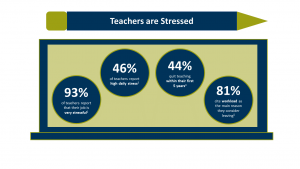Mindfulness in Teachers
Burning Bright, Or Burning Out?
Besides educating students in various subjects, teachers are in a position to inspire learning in their students and make a difference in their lives, an experience which can be incredibly rewarding. Though often a labor of love, teaching is also highly stressful. A heavy workload combined with the emotionally demanding nature of the job can lead to burnout. Things that begin as challenges can quickly transform into stressors, and teachers who were once enthusiastic about their work are now finding themselves irritable, impatient, anxious, and unable to relax[1].

To combat burnout and promote wellness, educators are turning to mindfulness to help cope with the challenges of running a classroom. But when a teacher’s daily routine includes marking, preparing for and delivering lessons, managing their classroom, and attending meetings—among other responsibilities—mindfulness practice might sound like another item on a never-ending “to-do” list. However, mindfulness is a valuable addition to the teaching “toolbox”: it not only improves well-being, but also benefits the classroom[6].
Mindfulness Promotes Teacher Well-Being
When a potentially stressful situation arises, mindfulness helps us take a step back, breathe, and think instead of giving in to knee-jerk reactions. Mindfulness also conveys other benefits related to well-being and emotional intelligence.
- Improved emotion regulation[7]. Mindfulness makes people more aware of their emotions, what triggers those emotions, and how their body reacts in different situations. By becoming aware of their own internal states, people can better control their emotions and respond mindfully, rather than automatically, to what is going on around them, such as a student being disruptive.
- Reduced burnout[8]. Burnout is a form of physical and emotional exhaustion that results from chronic stress. Mindfulness acts as a protective factor against the negative effects of burnout by reducing the body’s reactivity to stress and cultivating psychological resilience.
- Increased self-compassion[9]. Self-compassion involves showing ourselves kindness and forgiveness when things get tough. Instead of criticizing ourselves, self-compassion involves accepting that we’re only human: we make mistakes, have limitations, and don’t always achieve our goals.
Getting Started with Mindfulness
Mindfulness practice doesn’t have to be a chore: it takes as much time as you are comfortable investing. Get started with a brief guided meditation during your lunch break, or try taking a mindful pause when the day gets hectic. Explore other ways to fit mindfulness into your day. Alternatively, try one of our workshops for a more formal introduction to mindfulness.
How SIGMA Can Help
SIGMA offers a range of services to help you introduce mindfulness into your life and sustain your practice over time. Check out our mindfulness page for our webinar, a sample of our mindfulness practices, and our workshop offerings for more information. If you’d like to learn more about how mindfulness can benefit you, contact us today.
References
[1] Richards, J. (2012). Teacher stress and coping strategies: A national snapshot. The Educational Forum, 76, 299-316. doi:10.1080/00131725.2012.682837
[2] Herman, K. C., Hickmon-Rosa, J., & Reinke, W. M. (2018). Empirically derived profiles of teacher stress, burnout, self-efficacy, and coping and associated student outcomes. Journal of Positive Behavior Interventions, 20, 90-100. doi:10.1177/1098300717732066
[3] Gallup. (2014). State of America’s schools: The path to winning again in education. Washington, DC: Gallup. Retrieved from https://www.gallup.com/services/178769/state-america-schools-report.aspx
[4] Ingersoll, R. M., Merrill, E., Stuckey, D., & Collins, G. (2018). Seven trends: The transformation of the teaching force. CPRE Research Reports. Retrieved from https://repository.upenn.edu/cpre_researchreports/108
[5] National Education Union. (2018, April 3). NEU survey shows workload causing 80% of teachers to consider leaving the profession. Retrieved from https://neu.org.uk/press-releases/neu-survey-shows-workload-causing-80-teachers-consider-leaving-profession
[6] Jennings, P. A., & Greenberg, M. T. (2009). The prosocial classroom: Teacher social and emotional competence in relation to student and classroom outcomes. Review of Educational Research, 79, 491-525. doi:10.3102/0034654308325693
[7] Emerson, L., Leyland, A., Hudson, K., Rowse, G., Hanley, P., & Hugh-Jones, S. (2017). Teaching mindfulness to teachers: A systematic review and narrative synthesis. Mindfulness, 8, 1136-1149. doi:10.1007/s12671-017-0691-4
[8] Iancu, A. E., Rusu, A., Măroiu, C., Păcurar, R., & Maricuțoiu, L. P. (2018). The effectiveness of interventions aimed at reducing teacher burnout: A meta-analysis. Educational Psychology Review, 30, 373-396. doi:10.1007/s10648-017-9420-8
[9] Jennings, P. A. (2015). Early childhood teachers’ well-being, mindfulness, and self-compassion in relation to classroom quality and attitudes towards challenging students. Mindfulness, 6, 732-743. doi:10.1007/s12671-014-0312-4